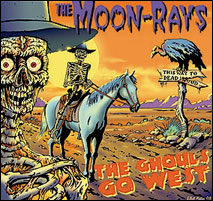 The
Moon-Rays The
Moon-Rays
The
Ghouls Go West
Spook Along with The Moon-Rays!
The latest release by The Moon-Rays is a self-contained
spook show on a little plastic disc, deftly moving from one
musical style to another, at times evocative and haunting, at
other times celebrating horror fan culture with monster kid
exuberance and plenty of reverb. A musical mixture of martinis
and monsters, this compact disc is the distilled essence of
cool.
Who are The Moon-Rays? There is nothing else quite like
them on the music scene today. Almost impossible to describe,
let's just say The Moon-Rays are the world's only surf-rock-jazz-blues
combo with a musical affection for monster movies, pop culture
TV, horror hosts and some outer space and spy exotica. And as
disjointed as the diverse musical styles sound, The Moon-Rays
make it work -- spectacularly so on their latest release THE
GHOULS GO WEST.
Located in the Chicago area, The Moon-Rays specifically
are Harry Reinhart (guitars, percussion); Greg Griffiths (piano,
keyboards, percussion); Scott Mensching (drums, percussion,
vibraphone, theremin and vocals on Thrillville); Tony DiMichele
(bass); Terry Bernett (sax); and Paul Miller (trumpet, fluglehorn).
One of the hardest things to achieve as recording artists is
to create something exciting while remaining tasteful. And here,
the musicianship is first rate, the instrumentation keeps things
interesting and the arrangements are clever. Musically, The
Moon-Rays speak the language of cool. Fluently.
Let's take a look at each exciting track.
Fear -- (3:36) Harry Lubin
The first piece is an otherworldly reworking of Lubin's theme
from ONE STEP BEYOND, a Twilight Zone-like show from the early
1960s. The special appeal of the show was the gimmick that the
stories were purportedly true. Like the memory of a loved one
lost to eternity, the first few measures of the melody sound
like they are emanating from a haunted victrola -- or from the
deepest, black and white reaches of the human soul. The first
several measures are purposely tinny sounding with clicks and
pops thrown in for authenticity. The theme is suddenly reborn
in living color with lush, layered guitars. Then atonal textures
purr, cry and wail like lost souls. Finally, a full orchestration
of the melody is allowed to bring the piece to a close. This
is one spooky bit of exotica.
Blues for Vampira -- (3:49) Mensching
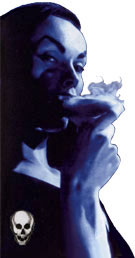 Like
Maila Nurmi herself, this cut is uncompromising in its presentation.
If Vampira did a striptease, this is the music she would have
used. Slow, retro and rock-steady, a repeated piano note and
restrained percussion drive the rhythm along as a flirtatious
bass-line swaggers along like Vampira's hips. Silky smooth,
a vibraphone kicks in the melody with all the colors of the
night. The opening bars somewhat echo the first few strains
of "I Was a Teenage Brain Surgeon" from the old Spike Jones
album IN STEREO: A SPOOKTACULAR IN SCREAMING SOUND, with the
first few descending notes of the vibraphone mimicking Thurl
Ravenscroft's vocal. But the resemblance ends there as the track
moves into the dark, cobweb-festooned recesses of Vampira's
attic. Almost unnoticeable, a quavering note on the high end
suggests a feeling of unease throughout the piece as a theremin
provides the eerie punctuation. (There's a touch of Angelo Badalamenti
lurking here and elsewhere on this album.) Pacing itself, the
piece builds upon the tension of the rhythm until Harry Reinhart's
guitar rips open the night with a blistering, bluesy solo. Somewhat
Gary Moore-like, the solo is breathy and hot--almost as if the
licks were caressing each curve of Vampira's wasp-waisted figure
like the mist that swirled about her as she strode through the
set at the opening of her show. If you know anything about Maila
Nurmi's career as the "mistress of the horror kid," you'll find
this piece hauntingly evocative of it. It is haunting, sensuous
and sad--but ultimately triumphant. Like
Maila Nurmi herself, this cut is uncompromising in its presentation.
If Vampira did a striptease, this is the music she would have
used. Slow, retro and rock-steady, a repeated piano note and
restrained percussion drive the rhythm along as a flirtatious
bass-line swaggers along like Vampira's hips. Silky smooth,
a vibraphone kicks in the melody with all the colors of the
night. The opening bars somewhat echo the first few strains
of "I Was a Teenage Brain Surgeon" from the old Spike Jones
album IN STEREO: A SPOOKTACULAR IN SCREAMING SOUND, with the
first few descending notes of the vibraphone mimicking Thurl
Ravenscroft's vocal. But the resemblance ends there as the track
moves into the dark, cobweb-festooned recesses of Vampira's
attic. Almost unnoticeable, a quavering note on the high end
suggests a feeling of unease throughout the piece as a theremin
provides the eerie punctuation. (There's a touch of Angelo Badalamenti
lurking here and elsewhere on this album.) Pacing itself, the
piece builds upon the tension of the rhythm until Harry Reinhart's
guitar rips open the night with a blistering, bluesy solo. Somewhat
Gary Moore-like, the solo is breathy and hot--almost as if the
licks were caressing each curve of Vampira's wasp-waisted figure
like the mist that swirled about her as she strode through the
set at the opening of her show. If you know anything about Maila
Nurmi's career as the "mistress of the horror kid," you'll find
this piece hauntingly evocative of it. It is haunting, sensuous
and sad--but ultimately triumphant.
There have been countless spook-oriented instrumentals
since the beginning of the rock era. Most of them have been
run-of-the-mill with haunted house effects and horror-theme
fills and cliches. Much rarer are those pieces that are evocative
of the uncanny within the composition itself. I have perhaps
a thousand horror-themed tracks in my collection; I think Blues
for Vampira just may be the best piece of instrumental spookery
ever recorded.
The Ghouls Go West -- 3:05) Griffiths
What a fun piece. If Vic Mizzy got hold of the theme from
THE MUNSTERS and played it sideways, it would sound sort of
like this. A trippy harpsichord lays down a quirky tune as a
theremin answers with its own counter-melody before both instruments
join together for the finale. Just imagine THE GHOST AND MR.
CHICKEN meets THE SHAKIEST GUN IN THE WEST and you've got it.
The Grim Creeper -- 5:09 Reinhart
Dark and ominous, there's murder in the air. A guitar pick
is dragged downward over the wound strings of a guitar, evoking
the feeling of life seeping from a victim. He probably had it
coming. If neon light filtering through venetian blinds onto
a body on the floor in a pool of blood next to a duchess with
nice gams and a revolver in her hand had a theme, this would
be it. The bass line walks down a wet cobblestone alley as guitars
and an organ shadow each other for the duration. Good guys,
bad guys, there's no distinction. In this piece everybody is
guilty of first-degree musicianship.
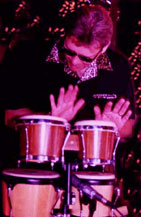 Dragula
Go-Go -- 3:06 Mensching Dragula
Go-Go -- 3:06 Mensching
Here's a little retro rocker for all you throttle jockeys.
Hey, it's about time Grandpa's custom coffin rail got a song
of its own. After all, it was Grandpa who won back the family
Koach in a grudge match after Herman goofed it again. You get
neat-o surf guitar work backed by some bold brass as spies in
porkpie hats provide the rhythm groove. You can hear the guitar
riff in the background pump like pistons as sax and guitar trade
solos. Frenetic bongos from weirdsville and kids (Garett and
Ally Menshing) yellin' "GO! GRANDPA, GO!" complete the effect.
Thrillville -- 3:31 Mensching
Like, dig this swinging ode to San Fransisco Bay area scene-makers
Will "The Thrill" Viharo and his wife Monica, the Tiki Goddess.
The Thrill and his Goddess have a floating stage show combining
Rat Pack chic, b-movies and burlesque. And this little number
seems just right for them. Man, I'm talkin' 99 44/100ths percent
pure hipster heaven, dad. A cool coffee-shop bass (Adam Kraus)
thumps along as brushes dance on the snare, while a lonely muted
horn plays along, occasionally popping off the "Will the Thrill!"
motif. Bongos keep things Jake as Scott Mensching spews the
word pudding about the Beatnik King, his Tiki Goddess and Thrillville,
where monsters and spies drink side-by-side. Canary Patti Miller
provides some smokey background vocals. This is solid, Jackson.
You can't parody a genre successfully without having mastered
it and these cats know what is and isn't. This cut will leave
you wiggin' for more.
Little Green Men -- (3:18) Mensching
The Great Gazoo would get a kick out of this one. Inspired
by a late-night viewing of INVASION OF THE SAUCER MEN, this
track in described by the (ample) liner notes as "Jimi Hendrix
and Preston Epps get abducted by aliens and throw a bongo beach
party on Mars." That pretty much sums it up! Space age squeaks
and squawks punctuate sonic freeform guitar-work here. Little
Green Men is like aural Googie architecture.
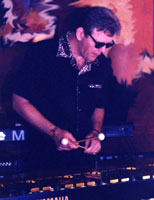 Dark
Shadows-Exotique -- (4:34) Robert Cobert Dark
Shadows-Exotique -- (4:34) Robert Cobert
On this adult reworking of the Dark Shadows theme,
The Moon-Rays emphasize the gothic romance without diminishing
much of its inherent creepiness. Still, it is more Angelique
than Barnabas. The guitar notes are rich; this is a classic
piece of supernatural exotica. Dig the faint birdcalls in the
background. But especially listen for the echoes of Franz Waxman's
BRIDE OF FRANKENSTEIN score as well; and does it ever work well
within the Dark Shadows context.. This is pure monster kid genius.
Like Blues for Vampira, it's also one very sexy number.
Man, I love this piece.
El Toro Gano (4:59) Reinhart
Arriba! There's a little black humor on this track as the
boys in the band stack the deck against the matador in this
bold, brassy enchilada. (El Toro Gano translates as "The
Bull Wins.") A tough rhythm track powers the groove underneath
some crazy flamenco guitar. Spanish horns herald the bull's
victory. Blood and sand indeed!
The Hanging Tree (3:50) Mensching
Listening to this I can't help but think of Grandpa Munster
(in the episode "Herman's Happy Valley") pointing to a noose
suspended from a gnarled, old oak in the middle of a ghost town,
remarking "Oh! Here are the excellent entertainment and recreational
facilities!" A desert wind heralds the opening bars of this
brooding oater that conjures up tons of pasta. But just as you
get used to the composition's dark vibe, it detours into bop-land.
It's a gutsy move and it works. The keyboard shines over some
tasty jazz comping on the guitar. Soon enough the track returns
to its dramatic roots of a necktie party in progress.
La Valse Du Vampir (2:58) Griffiths
Synthetic strings intertwine with piano to evoke a midnight
cotillion of the undead. On a disc of diverse tracks, this is
the most different cut on the album. Classical, almost New age,
the ominous undercurrent is unmistakable. But its ethereal quality
provides a wonderful coda for the THE GHOULS GO WEST. Was this
all a dream?
Packaging for the CD is first rate, with a ghoulish western
motif on the cover depicting rotting cowboys on horseback. The
artwork is by Elliott Mattice. The back cover shows everybody's
favorite ghoul girl, Vampira, sipping a cocktail. (Special kudos
to the group for getting permission to use Maila Nurmi's image.)
The liner notes satisfy those who want to know more about the
compositions. THE GHOULS GO WEST is a smashing accomplishment
for The Moon-Rays. There isn't a dud on the disc nor a false
note on any of the compositions. It is simply one of the best
albums of spook music ever recorded. Whether taken on its own
terms as monster music or accepted simply as good music, this
disc belongs in the collection of the discriminating monster
kid. You want this compact disc. And you can get it at www.ravenscott2000.com/Moon-Rays.html
along with earlier recordings by the group. The Moon-Rays are
indeed America's spookiest hipsters. Tell 'em The Monster Kid
sent ya.
Gary Prange
The
Moon-Rays website
|

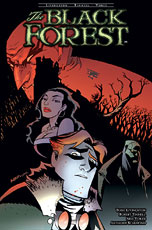 The
Black Forest
The
Black Forest 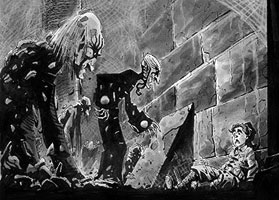 Though
the U.S. has yet to submit her troops to The Great War, a boyish,
bravado-filled American soldier named Jack Shannon, serving
under the flag of France, joins elder Englander Archibald Caldwell,
a master illusionist, escape artist, mystic, and occultist.
Their mission is to infiltrate the Black Forest, unravel the
mysteries surrounding The Castle of Black Shadows, and find
out just what the heck those nasty Germans are up to. The teaming
of the bold, brash Shannon and the cool, collected Caldwell
is a good one. Shannon, along with a sympathetically portrayed
Frankenstein monster, gives the story its heart and soul, while
Caldwell lends an air of old world sophistication to the perilous
proceedings. Caldwell also provides a direct rivalry with the
mad scientist (they love the same girl).
Though
the U.S. has yet to submit her troops to The Great War, a boyish,
bravado-filled American soldier named Jack Shannon, serving
under the flag of France, joins elder Englander Archibald Caldwell,
a master illusionist, escape artist, mystic, and occultist.
Their mission is to infiltrate the Black Forest, unravel the
mysteries surrounding The Castle of Black Shadows, and find
out just what the heck those nasty Germans are up to. The teaming
of the bold, brash Shannon and the cool, collected Caldwell
is a good one. Shannon, along with a sympathetically portrayed
Frankenstein monster, gives the story its heart and soul, while
Caldwell lends an air of old world sophistication to the perilous
proceedings. Caldwell also provides a direct rivalry with the
mad scientist (they love the same girl). 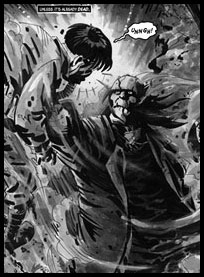 Like
Universal’s House of Frankenstein, House
of Dracula, and the recent Van Helsing,
The Black Forest is a morbid mishmash of
menacing and maniacal monsters. Naturally (or should that be
unnaturally?), Frankenstein is the star of the show, but writers
Todd Livingston and Robert Tinnell do an excellent job of infusing
werewolves, vampires (including Nosferatu), gypsies, and other
staples of the genre into the story without creating a sense
of chaos, confusion, or contrivance. The easy-to-follow plot
moves at a steady clip; the good guys (especially the likable
Shannon) are truly worth rooting for; and the glorious black
and white artwork is at once energetic, exciting, and mysterious,
lending a certain urgency to the many thrills, chills, and spills.
Neil Vokes’ drawings, scary as they are, may be a bit too
cartoonish or impressionistic for some tastes, but not everyone
can (or aspires to) draw like horror icon Bernie Wrightson.
Like
Universal’s House of Frankenstein, House
of Dracula, and the recent Van Helsing,
The Black Forest is a morbid mishmash of
menacing and maniacal monsters. Naturally (or should that be
unnaturally?), Frankenstein is the star of the show, but writers
Todd Livingston and Robert Tinnell do an excellent job of infusing
werewolves, vampires (including Nosferatu), gypsies, and other
staples of the genre into the story without creating a sense
of chaos, confusion, or contrivance. The easy-to-follow plot
moves at a steady clip; the good guys (especially the likable
Shannon) are truly worth rooting for; and the glorious black
and white artwork is at once energetic, exciting, and mysterious,
lending a certain urgency to the many thrills, chills, and spills.
Neil Vokes’ drawings, scary as they are, may be a bit too
cartoonish or impressionistic for some tastes, but not everyone
can (or aspires to) draw like horror icon Bernie Wrightson.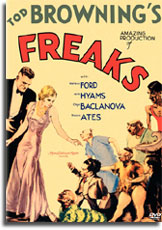 Freaks
Freaks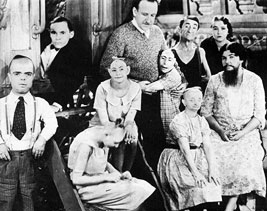 To
Browning's credit, from the very first view of them frolicking
in the woods, the movie attempts to garner sympathy and understanding
for its unusual cast. Most of their scenes are played very matter-of-factly
as glimpses of everyday life backstage of the sideshow. We meet
the armless girl eating dinner with her feet. The human torso
casually lights his own cigarette while listening to the acrobat
boast about his act, The human skeleton gives out cigars after
his wife, the bearded lady, has a baby, etc. We soon realize
that the real ugliness is found in the film's more physically
perfect specimens, Cleopatra the trapeze artist and Hercules
the strong man. After discovering that Hans the midget (Harry
Earles) is secretly wealthy, the two plot to do away with him
and steal his fortune. However, their contempt for the sideshow
attractions soon surfaces and offends the "code of the freaks"
which leads to the movie's famous and harrowing climax.
To
Browning's credit, from the very first view of them frolicking
in the woods, the movie attempts to garner sympathy and understanding
for its unusual cast. Most of their scenes are played very matter-of-factly
as glimpses of everyday life backstage of the sideshow. We meet
the armless girl eating dinner with her feet. The human torso
casually lights his own cigarette while listening to the acrobat
boast about his act, The human skeleton gives out cigars after
his wife, the bearded lady, has a baby, etc. We soon realize
that the real ugliness is found in the film's more physically
perfect specimens, Cleopatra the trapeze artist and Hercules
the strong man. After discovering that Hans the midget (Harry
Earles) is secretly wealthy, the two plot to do away with him
and steal his fortune. However, their contempt for the sideshow
attractions soon surfaces and offends the "code of the freaks"
which leads to the movie's famous and harrowing climax. The
disc features a very informative commentary by film historian
David J. Skal and a documentary that examines the real lives
and careers of the movie's strange stars and the production
history of the film. How to end the movie on a positive and
sympathetic note was apparently a problem and the disc features
an extra section examining the alternative versions of the final
scene and the epilogue that were written or filmed, which included
the original hair-raising (and voice raising) fate of Hercules.
The
disc features a very informative commentary by film historian
David J. Skal and a documentary that examines the real lives
and careers of the movie's strange stars and the production
history of the film. How to end the movie on a positive and
sympathetic note was apparently a problem and the disc features
an extra section examining the alternative versions of the final
scene and the epilogue that were written or filmed, which included
the original hair-raising (and voice raising) fate of Hercules. The
Moon-Rays
The
Moon-Rays Like
Maila Nurmi herself, this cut is uncompromising in its presentation.
If Vampira did a striptease, this is the music she would have
used. Slow, retro and rock-steady, a repeated piano note and
restrained percussion drive the rhythm along as a flirtatious
bass-line swaggers along like Vampira's hips. Silky smooth,
a vibraphone kicks in the melody with all the colors of the
night. The opening bars somewhat echo the first few strains
of "I Was a Teenage Brain Surgeon" from the old Spike Jones
album IN STEREO: A SPOOKTACULAR IN SCREAMING SOUND, with the
first few descending notes of the vibraphone mimicking Thurl
Ravenscroft's vocal. But the resemblance ends there as the track
moves into the dark, cobweb-festooned recesses of Vampira's
attic. Almost unnoticeable, a quavering note on the high end
suggests a feeling of unease throughout the piece as a theremin
provides the eerie punctuation. (There's a touch of Angelo Badalamenti
lurking here and elsewhere on this album.) Pacing itself, the
piece builds upon the tension of the rhythm until Harry Reinhart's
guitar rips open the night with a blistering, bluesy solo. Somewhat
Gary Moore-like, the solo is breathy and hot--almost as if the
licks were caressing each curve of Vampira's wasp-waisted figure
like the mist that swirled about her as she strode through the
set at the opening of her show. If you know anything about Maila
Nurmi's career as the "mistress of the horror kid," you'll find
this piece hauntingly evocative of it. It is haunting, sensuous
and sad--but ultimately triumphant.
Like
Maila Nurmi herself, this cut is uncompromising in its presentation.
If Vampira did a striptease, this is the music she would have
used. Slow, retro and rock-steady, a repeated piano note and
restrained percussion drive the rhythm along as a flirtatious
bass-line swaggers along like Vampira's hips. Silky smooth,
a vibraphone kicks in the melody with all the colors of the
night. The opening bars somewhat echo the first few strains
of "I Was a Teenage Brain Surgeon" from the old Spike Jones
album IN STEREO: A SPOOKTACULAR IN SCREAMING SOUND, with the
first few descending notes of the vibraphone mimicking Thurl
Ravenscroft's vocal. But the resemblance ends there as the track
moves into the dark, cobweb-festooned recesses of Vampira's
attic. Almost unnoticeable, a quavering note on the high end
suggests a feeling of unease throughout the piece as a theremin
provides the eerie punctuation. (There's a touch of Angelo Badalamenti
lurking here and elsewhere on this album.) Pacing itself, the
piece builds upon the tension of the rhythm until Harry Reinhart's
guitar rips open the night with a blistering, bluesy solo. Somewhat
Gary Moore-like, the solo is breathy and hot--almost as if the
licks were caressing each curve of Vampira's wasp-waisted figure
like the mist that swirled about her as she strode through the
set at the opening of her show. If you know anything about Maila
Nurmi's career as the "mistress of the horror kid," you'll find
this piece hauntingly evocative of it. It is haunting, sensuous
and sad--but ultimately triumphant. Dragula
Go-Go -- 3:06 Mensching
Dragula
Go-Go -- 3:06 Mensching Dark
Shadows-Exotique -- (4:34) Robert Cobert
Dark
Shadows-Exotique -- (4:34) Robert Cobert Drums
of Fu Manchu
Drums
of Fu Manchu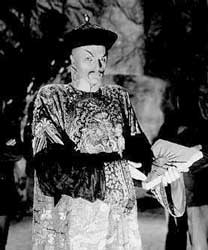 On
Our Side, you'll find longtime Fu Manchu aggravator Sir Nayland
Smith (he seems to have lost his first name, Denis, somewhere
in the script) and Sir Nayland's pesky American sidekick, Allan
Parker, a prettyboy who can hold his own when the fisticuffs
start, for the most part.
On
Our Side, you'll find longtime Fu Manchu aggravator Sir Nayland
Smith (he seems to have lost his first name, Denis, somewhere
in the script) and Sir Nayland's pesky American sidekick, Allan
Parker, a prettyboy who can hold his own when the fisticuffs
start, for the most part. 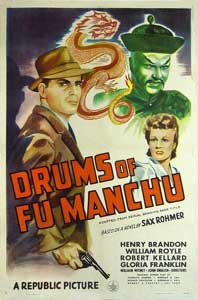 Like
most Republic 15-chapter serials, this one should've been cut
down to 12 episodes. Most of the good stuff occurs in the first
10 chapters, and the final free-for-all is nothing special,
although Fu Manchu's fate in chapter 15 is unique for a serial.
Like
most Republic 15-chapter serials, this one should've been cut
down to 12 episodes. Most of the good stuff occurs in the first
10 chapters, and the final free-for-all is nothing special,
although Fu Manchu's fate in chapter 15 is unique for a serial.